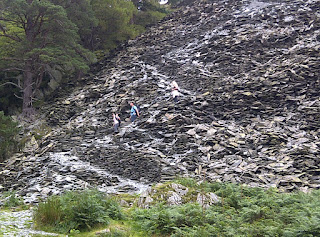Castle Crag is the lowest of the Wainwright fells standing
at only 951 feet and therefore you would think would be an easy stroll. In my view however, this little fell has
character that some of the larger fells can only aspire to. There are streams, crags, rocky paths, steep
stiles, scree-like slate slopes, memorials and a history that is
fascinating. I climbed it first in June
2011 and then several times since (once being in August 2011 with a large
family, but that is a story for another day) from the lovely hamlet of Grange
in Borrowdale. Grange is such a pretty
hamlet situated just over a double stone bridge on the river Derwent and has wonderful tea rooms for when you have
finished any local climbs (or indeed to provide sustenance in advance!)
 |
| Castle Crag |
The walk takes you along a path next to one of the tea rooms
and towards the River Derwent at the foot of Castle Crag. There is plenty to hold you up here as the
river, especially on a warm day, looks extremely inviting and I confess I have
paddled in it on several occasions (I will add at this point that one of those
occasions was by accident when I was looking too much at the beautiful
surroundings and not where I was putting my feet and consequently slipped off
the rocks and into the river – please note that paddling is best done after
removing your boots!) On this day (a dry
boot day) the sound of the water rushing over the rocks, catching the sun as
though there were a thousand stars just below the surface and the deep green
leaves hanging overhead from lazy trees was superb. Yet another of those “good to be alive”
moments.
There is a clear path up to the right of Castle Crag through
a gate and after a short walk you bear left up the slopes of the fell. This is where it gets steep and rocky amongst
the trees and you think you should be on the slopes of one of the much higher
fells! At the top of this steep part you
cross a stile and end up in a clearing that opens up views further into
Borrowdale. It is an unexpected little
haven. On each of the occasions I have
climbed this fell there have been primary school parties making the same
journey. It is wonderful to watch the
reaction of the children when they see this area – the “wows” and “oohs” are
plentiful. When I was that age I think I
was more one for phrases such as “are we nearly there yet” and “this is sooo
steep” and actually had not improved my comments much when I did an A-Level
Geography trip to the Blencathra Centre when I was 17 years old!
 |
| Slate Path |
After enjoying the views from the clearing, I started the
next part of my ascent and this is where the history of the fell starts to
become clear. Castle Crag has been mined
extensively and you can see the scars of this activity at various points on the
walk. At this point on the fell there is
what looks like a vast slate rock fall but actually if you look carefully, is a
slate path up towards the top of the fell.
At a glance it looks an impossible task but it is well crafted on closer
inspection and besides, if parties of school children could do it, so could
I! I did make sure I was looking where I
was putting my feet this time that is for sure!
As you emerge from the slate path just below the summit, you
are met by a mini Stonehenge. The story goes that someone
for some reason (and no one really knows who or why although there are variations)
has arranged pieces of slate in various upright positions surrounded by other
pieces of slate – like little slate islands in a sea of green grass. It is really eerie. Apparently sometimes they are knocked down
yet someone takes the time to rebuild them.
Who and why? Fascinating and very
mysterious!
A climb of a few more feet gets you to the summit where
there is a War memorial forming part of the cairn. The views down into the valley and back
towards Keswick and Derwent Water are stunning especially for such a low fell. You are captured by the majesty and pride of
a mountain that is small but feisty and should not be underestimated.
 |
| Summit Rock & Cairn |
The first part of the route down on the opposite side of the
fell is totally different to the ascent.
It takes you over grassy slopes, through woods and next to streams. There is less evidence of the scars of mining
but there are plenty of quarries, crags and caves to explore. One of the caves was occupied for many years
in the summer by a hermit called Millican Dalton, who died in 1947. He started occupying the cave at the age of
36 and became a climbing guide. He has
left the words “Don’t waste words. Jump
to conclusions” engraved inside.
Emerging back at the paddling area, after climbing this fell
I was left feeling I had conquered something much grander than I had expected
and with so much character that I have been back to it several times. As I said at the beginning, some of the
higher fells can only aspire to have the character and history of Castle Crag
and it may be small but it is a cracking fell.
 |
| Clancey the beautiful Lurcher on the summit |







